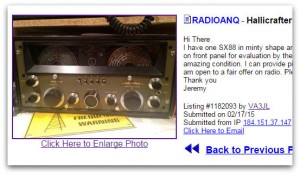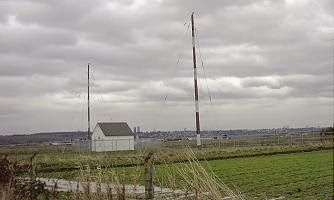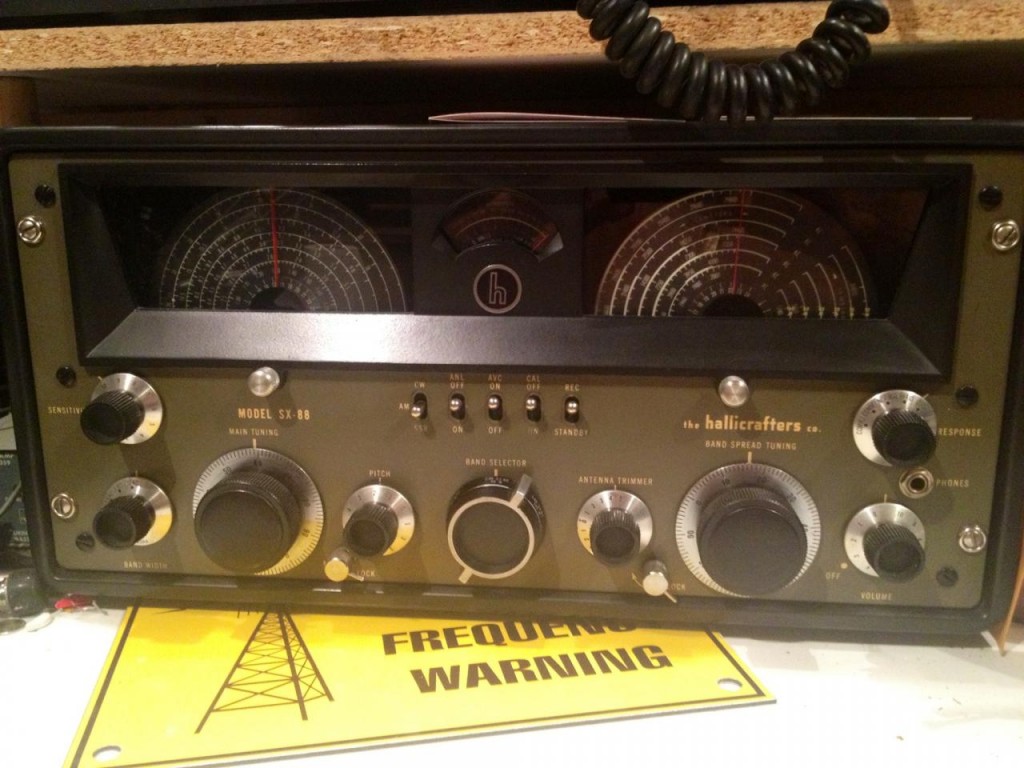 US Islands Award Program
US Islands Award Program
For FAQ on the program - go here: http://www.usislands.org/USI-1DG-FAQ.pdf
Might be an excuse to get down to Long Beach Island for the day.
72 de Larry W2LJ
QRP - When you care to send the very least!
Larry Makoski, W2LJ, is a regular contributor to AmateurRadio.com and writes from New Jersey, USA. Contact him at [email protected].
 The Hallicrafters SX-88: a rare find and a gem of engineering
The Hallicrafters SX-88: a rare find and a gem of engineering
[Note: this post first appeared on my shortwave radio blog, the SWLing Post.]
Yesterday while glancing through the QTH.com classifieds ads, I noticed a rare boat anchor for sale: the Hallicrafters SX-88.
The seller, Jeremy, describes this SX-88 as follows:
Hi [t]here, I have one SX88 in minty shape and is one of a handful that came in military green on [the] front panel for evaluation by the military. This is an exceptional radio in amazing condition. I can provide pics for someone who is seriously interested. I am open to a fair offer on radio. Please, no low-ballers. We all know what [it’s] worth…
 “We all know what it’s worth“–?
“We all know what it’s worth“–?
Well, it just so happened that my good friend (and Elmer, or ham radio guru) Mike Hansgen (K8RAT) had recently provided me with a little history lesson on the subject of the SX-88, so I did know what this rig is worth: a great deal of money.
But curiosity got the best of me, so I contacted Jeremy (a nice fellow, by the way) and asked what he was expecting to receive in exchange for his Hallicrafters SX-88? Jeremy’s reply:
“…$5,500 USD will take it. It is a very rare unit; it was… only one of about 6 [painted green]…for presentation to the military for evaluation.
That price is firm. [I] will not negotiate downward, and shipping [from Ontario, Canada] is extra.”
After receiving this response from Jeremy, I happened to think that I have the reference guide to rare/used shortwave receivers: Fred Osterman’s Shortwave Receivers Past and Present 4th edition. (Click here for more info.)
Osterman’s wonderfully comprehensive guide mentions that the SX-88 is a “highly regarded, rare and collectible model.” As for the rarity of the SX-88, he describes it thus: “Extremely Scarce.” The used price range he gives is from $3,500-7,000 US.
I also have Chuck Dachis’ book, Radios By Hallicrafters; in it, he states that the SX-88 is, “the most sought-after Hallicrafters model.” Wow.
After thanking Jeremy for his response, he replied:
“It’s a lot of money for a receiver for certain, but it is a fantastic shortwave receiver as the audio that comes out of it is amazing.
It has 10 watts of audio and into a big speaker–it is second to none. The fidelity is amazing and it is the king of its kind. [For those who like] tube rigs, it is the best of its kind.
For ham purposes on AM it is amazing, and on CW I find it incredible to use.
[W]hen they built this thing they intended to pull all [the] stops out and build the best radio they could for the day with the military in mind. It was an engineering marvel for the day.
Anyway, I have played with it for years now and need to thin out the herd.”
Impressive. And while I just don’t have that kind of money to fork out for a receiver, I did ask myself the question: “If I had $5,500 to blow, would I get that Hallicrafters SX-88?”
And my answer? Yes. In fact, I would personally drive to Jeremy’s home in Ontario and bring it back; no way I’d trust it to a parcel carrier or the post office…
Come on, you may say. For a guy who rarely pays over $50 for a vintage receiver, how could you possibly justify that kind of financial and time commitment–?
Well, let’s think of it this way. I remember when when I paid well over two thousand for my first laptop in college. How much is it worth now? Maybe twenty dollars–?
Many people have retirement funds in investments, some of which are in a variety of innovative companies that they actually patronize–for example, Apple or Microsoft. But how often can you find an investment that you can actually play with? One which you can turn on, tune in, work the controls, and enjoy?
Yes, I’m sure this is just the sort of justification voiced by many a vintage car collector…So, why not for a museum-worthy radio? After all, they’re not making these anymore.
I expect this Halli will not only hold its value, but will probably increase in value over time.
Ah, well; fun to ponder. My question to you: Would you buy a $5,500 vintage receiver if you had it to spare?
If your answer is yes, and you do have the money, then you might want to contact Jeremy.
I’m very curious if there are any SX-88 owners among our readership? If so, please comment with your thoughts about the ’88!
And for the rest of us, just so we can revel in the vicarious pleasure of ownership, I’ve included some additional information about the Hallicrafters SX-88 below, including two videos.
Resources (courtesy of Jeremy):
[youtube http://www.youtube.com/watch?v=ozclVUwZ_mM]
[youtube http://www.youtube.com/watch?v=clF5HsewTnU]
Tom Witherspoon, K4SWL, is a regular contributor to AmateurRadio.com and writes from North Carolina, USA. Contact him at [email protected].
 AM on 28MHz and up
AM on 28MHz and up
Much to my surprise, the RSGB actually published my recent letter to their “The Last Word” column in RadCom, together with a (pathetic) reply from their Spectrum Chair. At least my letter was printed.
The response did nothing to address my concerns. Although the RSGB claims not to be anti-AM, you’d find this hard to believe with a look at the most recent band plans. AM has its place on all bands from 28MHz upwards. I just wish the RSGB and other national organisations would simply acknowledge that this mode has its place. It may be a minority interest mode, but in my experience it is the simplest mode from a building viewpoint.
Roger Lapthorn, G3XBM, is a regular contributor to AmateurRadio.com and writes from Cambridge, England.
 Monday brings two dx contacts
Monday brings two dx contacts
late afternoon it was time to go out with Julie who had a photography assignment that involved us going downtown (Toronto) for some shots she needed to get. It sure was cold out but soon we would be back to our warm home and just a little more radio time as she edited some photos. This time on 20m I heard HC5AI calling CQ from Ecuador and after some going back and forth he got my call and the contact was made.
Mike Weir, VE9KK, is a regular contributor to AmateurRadio.com and writes from New Brunswick, Canada. Contact him at [email protected].
 Hunting For NDB’s In CLE191
Hunting For NDB’s In CLE191
 |
| One CLE Target - 'VR' 266KHz / Vancouver Int'l Approach |
How time flies. For you low-frequency buffs, another challenge awaits. From CLE coordinator Brian Keyte (G3SIA) comes the following reminder:
"Our February Co-ordinated Listening Event will soon be here.
We'll be hunting for normal beacons in two contrasting frequency ranges.
One range also gives the possibility of hearing several amateur beacons.
As always, first-time CLE logs will be extra welcome.
Days: Friday 20 February - Monday 23 February
Times: Start and end at midday, your local time
Frequencies: 260.0 - 269.9 kHz
plus: 440.0 - 1740.0 kHz
Many of us should be able to hear beacons in both ranges, though Europe
only has a handful in the '260s'. From 440 onwards, Eastern Europe and
North Africa have several beacons and some regular UNIDs and some NDBs
can be found among Europe's Medium Wave Broadcast Stations.
Many of us are within range of some of the amateur beacons on frequencies around 470 kHz and 500 kHz - we'll be listening for ANYTHING OPERATING IN BEACON MODE, preferably with normal speed Morse.
(We ask operators who sometimes use QRSS, PSK, WSPR, etc., which need
software to receive them, to PLEASE CHOOSE THE SIMPLER MODE during
the CLE so that we shall all be able to receive and report them).
Send your CLE log to the List, preferably as a plain text email
and not in an attachment, with CLE191 at the start of its title.
Please show on EVERY LINE of your log:
# The full Date (or Day no.) and UTC (the day changes at 00:00 UTC).
# kHz (the beacon's nominal published frequency, if you know it)
# The Call Ident.
Other optional details, Location, Distance, etc., go LATER in the same
line (or in footnotes). Any extra details about UNIDs, especially strong
ones that may be near to you (maybe their approximate direction, etc.)
will help us to discover more about them. As always, please make your
log useful to old and new members alike by including your own location
and brief details of the equipment and aerial(s) you were using.
I will send an 'Any More Logs?' email at about 18:00 UTC on Tuesday
evening. From it you can check that your log has been found OK.
Do make sure that your log has arrived at the very latest by 09:00 UTC
on Wednesday 25 February.
I hope to finish making the combined results on that day."
These listening events serve several purposes. They:
- determine, worldwide, which beacons are actually in service and on-the-air so the online database can be kept up-to-date
- determine, worldwide, which beacons are out-of-service or have gone silent since the last CLE covering this range
- will indicate the state of propagation conditions at the various participant locations
- will give you an indication of how well your LF/MF receiving system is working
- give participants a fun yet challenging activity to keep their listening skills honed
Final details can be found at the NDB List website, and worldwide results, for every participant, will be posted there a few days after the event. If you are a member of the ndblist Group, results will also be e-mailed and posted there.
The very active Yahoo ndblist Group is a great place to learn more about the 'Art of NDB DXing' or to meet other listeners in your region. There is a lot of good information available there and new members are always very welcome.
If you are contemplating getting started on 630m, listening for NDBs is an excellent way to test out your receive capabilities as there are several NDBs located near this part of the spectrum.
You need not be an ndblist member to participate in the CLEs and all reports, no matter how small, are of much value to the organizers. 'First-time' logs are always VERY welcome!
Reports may be sent to the ndblist or e-mailed to either myself or CLE co- ordinator, Brian Keyte (G3SIA), whose address appears above.
Please...do give the CLE a try....then let us know what NDB's can be heard from your location! Your report can then be added to the worldwide database to help keep it up-to-date.
Steve McDonald, VE7SL, is a regular contributor to AmateurRadio.com and writes from British Columbia, Canada. Contact him at [email protected].
 Internet of Things (IoT) already here
Internet of Things (IoT) already here
This morning I received this email from KK4HSX saying that (certainly in the USA) Amazon is already selling wifi connected slow cookers called “Crock Pots”. Not sure if this is a stateside generic term.
It’s already here. Behold,the Crock Pot you can monitor and control with you phone.
http://www.amazon.com/Crock-
Pot-Wifi-Enabled-6-Quart- Cooker-SCCPWM600-V1/dp/ B00IPEO02C#
Roger Lapthorn, G3XBM, is a regular contributor to AmateurRadio.com and writes from Cambridge, England.
 Landwade
Landwade
Landwade was the site of my first “over the horizon” optical tests. The tests were successful, but predate my stroke by some time. I remember well being surprised at the reception when “on beam”.
We go here each year about this time for a delightful walk of about 1.5km calling at the small private church (locked these days). The church is surrounded by seas of snowdrops and aconites at this time of year. Landwade is very quiet at all times. It is in Suffolk but was in Cambridgeshire until 1994. It has been occupied since Roman times, but consists of a few farms, a hall and the odd cottage these days.
I have updated one of my other blogs.
See http://eachurches.blogspot.co.uk/ .
Roger Lapthorn, G3XBM, is a regular contributor to AmateurRadio.com and writes from Cambridge, England.

















